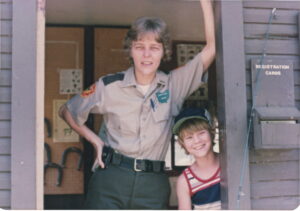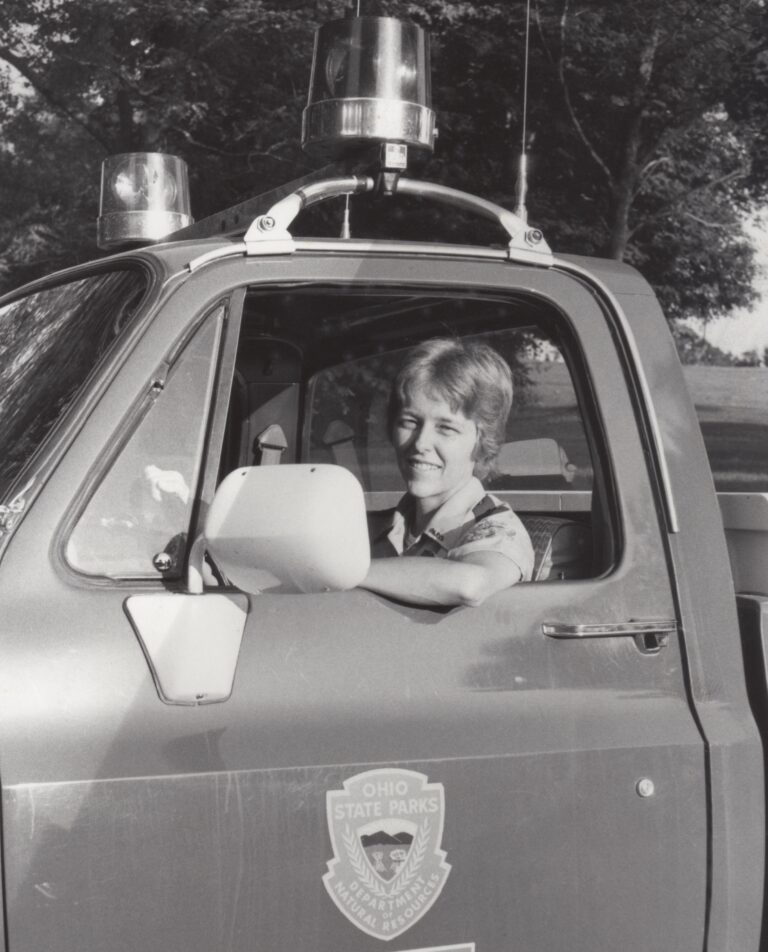In about 1980, when I was working as a Naturalist/Ranger in the Greene County, Ohio park system, Indian Mound Reserve was the most abundant park in my care, and my favorite. The beautiful Massies Creek runs through it, creating rock formations and multiple habitats for animals and plants. The field around the mound, for which the park was named, was a favorite meditation area for me, and the mound itself gave me chills and other physical sensations whenever I was near it. It was said to be built along ley lines in the area, aligned with the magnetic flow there. I found it difficult to protect from cyclists and others who found it to be a fun hill, rather than a sacred spot. In my law enforcement capacity, I tried to use my ranger uniform more for education than scolding or punishment, which mostly worked. I found that if people understood the reason for a rule they were more likely to respect it; for example, to protect a slope from teenagers who used it as a slide to the water, I surprised them with a fact they found fascinating; there was a special lichen on that slope which takes fifty years to mature.
Indian Mound Reserve also embraced a high plateau, wild with native plants, overlooking a deep and long valley below, rich with lush flora and abundant fauna. This plateau, part of the whole park’s Native American lineage was known only as ‘The Fort Enclosure,’ a name I found to be a white man’s term likely bearing little resemblance to what occurred there when it was occupied. The area was indeed protected as a military installation might be, but not by walls. It was virtually inaccessible on three sides by cliffs and, on the other by mounded entry points built with earthworks.
No one in the park system knew the park’s full history and I discovered local Native people were not friendly to outsiders, probably caucasian park employees in particular. The county ‘owned’ the mound and the land surrounding it. I had contacted a local Native American group proposing that they offer public educational talks to help protect the area through understanding, but I was not welcome. Also, caucasians were known to be appropriating Native cultural and spiritual traditions in a groundswell of misguided effort to rekindle their own relationship with nature. So I continued to educate the public myself about things I knew: the preciousness of a healthy ecology, fostering curiosity and respect for the wonders of the natural world. I led hikes and directed programs, and as a law enforcement officer, I tried to protect the diverse habitat under our care.
But I had no authority over use of the reserve by a Wright State University archeology team who wanted to do a dig at the base of the enclosure. They were looking for ‘Indian artifacts.’ It hurt my heart. I considered their work to be a violation of sacred ground but there was nothing I could do but pray for the grounds, the species there, and the ancestors of this beautiful place, while checking in on their use of the area when I patrolled.
The dig took place in a fairly remote area of the park at the base of the plateau enclosure where humans seldom trod, and a raccoon began ‘annoying’ the archeologists. It was spring. Could it be the raccoon was protecting its home and its family from intruders? In my ranger role I was called to the dig site to investigate and I spoke to the men there who claimed the raccoon was harassing them. I didn’t say aloud, “Who is harassing whom, here?!” but I did ask about the animal’s behavior and offered the possibility that their work and presence were disturbing the animal’s home and family. They had not thought of that. Understandable. We are not taught these things. Yet they were not interested in altering their work in any way, to accommodate an animal.
In the light of day, the raccoon was looking down on us from high up in a nearby tree. It looked scared to death, from my perspective, and about to fall asleep on a branch. It did not appear to be aggressive or ill, from what I could tell. Nevertheless, protocol dictated that I call the county’s game protector to come out and evaluate. I knew what this might lead to. My ranger uniform did not not include a gun but his did, and it was possible that he would shoot the raccoon so work on the dig could continue, undisturbed. When he arrived we talked for a while and I made humane suggestions, but in the end he did shoot the raccoon down from the tree. The head would be sent to a lab for analysis to see if the animal was rabid.
I didn’t ask to see the lab report. Maybe if I had found out the animal was, indeed, ill, I might have felt better but I doubted that it was. It did not appear rabid to me, more like frightened and sleepy from daytime disturbance. I carried guilt for that raccoon’s death. I went over it in my mind thinking of all the things I could have done first: given the situation more time, cleared the men out for a while to observe the raccoon’s behavior myself, called another naturalist, looked for raccoon babies in the area, which would explain a lot, then move the family. I was angry at the callousness of humans and our abuse of power over other species.
Eventually, my guilt over the incident receded but it never went away. I felt I owed a debt to the species. Then, one sunny day the following year, as I was walking along a heavily wooded nature trail nearer my home, I remembered that raccoon and felt a stab in my heart. Only moments later, I looked up to see a shaft of bright yellow light piercing the thick canopy to shine directly onto an otherwise shaded trail in what appeared to be a perfect circle. Smack in the middle of that light sat a raccoon, up on hind legs, staring at me as I stopped. And it just kept staring. My eyes teared up and I swear it smiled, in a raccoon way of course. I swear it did, so I smiled back. This animal thanked me for caring so much and told me its species was doing just fine. I was forgiven. It was phenomenal to feel completely absolved for my part in the raccoon’s death. I wondered, too, if my culture could ever be forgiven for violating sacred land.
Many years later I was privileged to offer teachings about relationships with Mother Nature and her animals. I encouraged people to deeply experience what was in their heart at any given moment in concert with what they witnessed with their eyes and ears; to find meaningful relationships through synchronicity and felt senses in order to embody the spirit of place and relatedness. I offered this as an alternative to simply looking up animal symbolism in books, which was popular at the time. Books and teachings by indigenous cultures are valuable resources and we desperately need them, especially we caucasians who have much to make up for, but personal relationship with our non-human relatives is also desperately needed in these times if we are to find the balance we seek. This, I felt, was the most important thing I could share with others.
As for the raccoon, I have since been bothered by raccoons while camping and annoyed by them in my trash but, for me, a raccoon is always about forgiveness.

